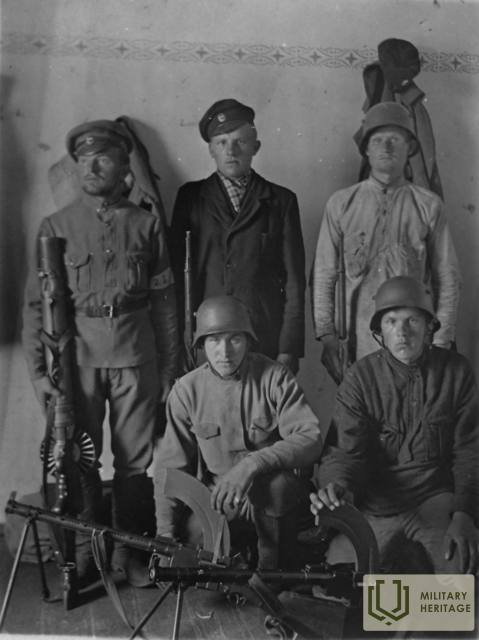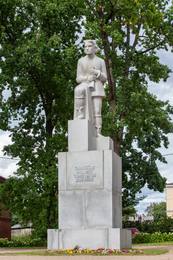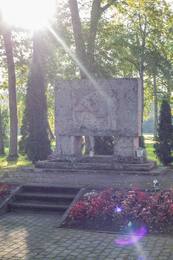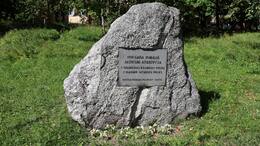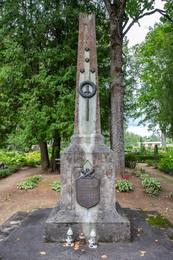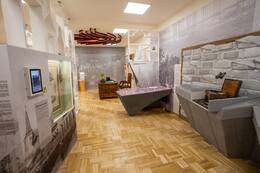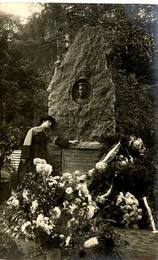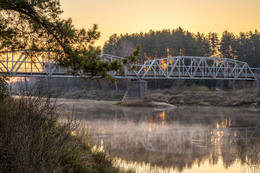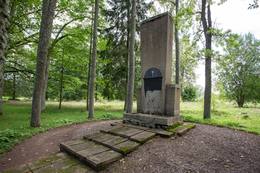Northern Latvia Brigade I Wars of Independence
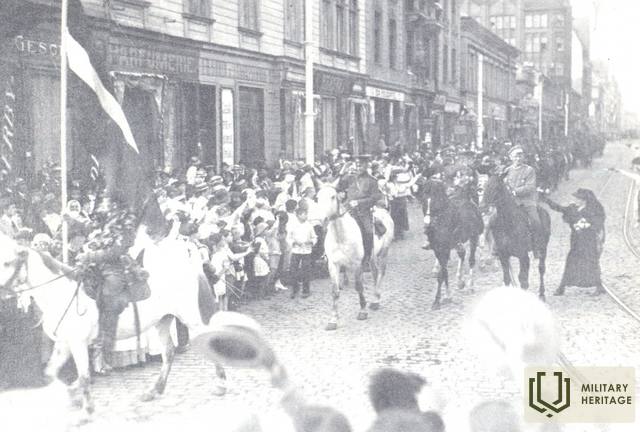
The Northern Latvian Brigade was a Latvian military formation during the Latvian War of Independence, which was formed in February and March 1919, following an agreement between representatives of the Latvian and Estonian governments, in the territory of Estonia and the Northern Vidzeme regions liberated by the Estonian army.
On February 3, the Minister of Defense of Latvia, Jānis Zālītis, appointed Jorģis Zemitāns as the organizer and commander of all Latvian troops in Estonia and Northern Latvia, and engineer Markas Gailītis as his authorized representative in civil affairs. The 1st Valmiera Infantry Regiment was formed in a short time and at the end of March it went to the front. On March 31, by order of the Commander-in-Chief of the Estonian Army, the Northern Latvia Brigade was established under the command of Colonel Zemitāns, with headquarters in Tartu. Zemitāns appointed Lieutenant Colonel Edvards Kalniņš as his assistant, who also commanded the artillery. The chief of staff was Lieutenant Colonel Voldemārs Ozols. Until July 1919, the brigade was subordinate to the headquarters of the Estonian Armed Forces and the Commander-in-Chief of the Estonian Army in terms of logistics and operations.
At the end of May 1919, the North Latvian Brigade consisted of the 1st Valmiera Regiment with 1,100 soldiers, the 2nd Cēsis Regiment with 1,700 soldiers, the Partisan Regiment with 200 soldiers, one squadron with 50 cavalrymen, the 1st Valmiera and 2nd Cēsis artillery batteries with 210 soldiers, and a reserve battalion with 320 reservists. In total, it consisted of 110 officers and 3,400 soldiers. The brigade lacked weapons, and many soldiers initially wore civilian clothes and shoes, or walked barefoot.
From the beginning of April 1919, the North Latvian Brigade, together with the Estonian Army, fought against the Bolshevik Red Army to liberate Vidzeme. In June, the North Latvian Brigade participated in the Battle of Cēsis against the Baltic Landeswehr and the Iron Division, in which they won a victory together with the Estonian Army. After the conclusion of the Strazdumuiza Armistice on July 3, the North Latvian Brigade entered Riga on July 6.
In July 1919, when a unified Latvian army was formed, the North Latvian Brigade was transformed into the Vidzeme Division.
More information sources
Ēriks Jēkabsons. Latvian War of Independence. The struggle of the Latvian Provisional Government and its armed forces to ensure the independence of Latvia from 18.11.1918 to 11.08.1920. – National Encyclopedia: https://enciklopedija.lv/skirklis/22216-Latvijas-Neatkar%C4%ABbas-kar%C5%A1
Northern Latvian Brigade. Wikipedia. https://lv.wikipedia.org/wiki/Zieme%C4%BClatvijas_brig%C4%81de
The Fight for Freedom: The Latvian War of Independence (1918–1920) in the Documents of the Latvian State Historical Archive, Part 1, November 18, 1918–April 16, 1919, comp. Ē. Jēkabsons and J. Šiliņš, Riga, Latvian National Archives, 2019.
“Fight for Freedom: The Latvian War of Independence (1918–1920) in the Documents of the Latvian State Historical Archive” Part 2. April 16–July 10, 1919, comp. Ē. Jēkabsons and J. Šiliņš, Riga, Latvian National Archives, 2019.
Related timeline
Related objects
Monument “Tālavas taurētājs”
Located in Rūjiena Center Square.
The three-meter-high image of an ancient Latvian guard soldier, carved from gray Finnish granite, called the “Tālavas trumpeter”, is placed on a three-meter-high granite pedestal, but the total height of the monument reaches 7.5 meters. In the initial sketches and models, K. Zemdega had placed a sword in the warrior’s hands, which was later replaced with a trumpet. The monument was unveiled on August 15, 1937.
This monument reflects the difficult situation in the formation of our state and army, as well as the assessment of these events. Immediately after the proclamation of the Latvian state, the Red Army invasion began and the provisional government of Kārlis Ulmanis found refuge in Liepāja. In February 1919, with the help of the Estonian army, the liberation of Latvia from the north began and the first mobilizations of the Latvian troops being formed in Tērbatas took place in the Rūjiena area, which, under the command of Colonel Jorģis Zemitāns, became the North Latvian Brigade. The North Latvian Brigade fought not only against the Bolsheviks, but also against the Landeswehr and the Iron Division in the battles of Cēsis. The North Latvian soldiers mobilized in the Rūjiena area also fought in subsequent battles of the War of Independence. After the war, the main laurels of victory went to General Jānis Balodis and the South Latvian Brigade commanded by him, but the North Latvian Brigade was often forgotten. The planned monument to the North Latvian Brigade in Rūjiena also took a long time to be created, and the monument, unveiled in 1937, was officially promoted as a monument to the liberation of the Rūjiena region and in memory of the fallen soldiers, without mentioning that all the regiments that were part of the North Latvian Brigade had their beginnings in Rūjiena.
The monument is not only a popular tourist attraction for Latvian and Estonian tourists, which is to some extent a starting point for visiting several other War of Independence memorial sites in Rūjiena, but the "Tālavas tauretājs" is also a stopping point for visits by Estonian and Latvian state and local government officials of various levels.
The Rūjiena Liberation and Fallen Soldiers Monument, more commonly known as the "Tālavas tauretājs" (Far-away Horner), was included in the list of state-protected cultural monuments on October 29, 1998 as an art monument of national importance (monument protection registration number 4522).
Monument to the Liberators of Northern Latvia
Located in the center of Plāčis near the Inčukalns - Valkas highway (A3). Next to the bus stop and Straupes Community Center.
The monument created by Teodors Zaļkalns to the liberators of Northern Latvia in the Battle of Cēsis in 1919 is visible.
On a three-tiered base, two travertine pillars are placed, on which a travertine block rests. On its front, a bas-relief depicts a horse harnessed to a plow and a plowman, who holds the reins in his right hand and a sword in his left. On the back of the monument is carved a text, which concludes with the lines of the poet Eduards Virza:
TO THE LIBERATORS OF NORTHERN LATVIA
WHILE ONE GRAIN IS SOWED IN THIS FIELD
YOU WILL BE PRAISED AND HONORED
The monument was unveiled on November 8, 1931. The opening was attended by President Alberts Kviesis.
Memorial stone to the liberators of Alūksne
Located in Alūksne, at the intersection of Helēnas and Alsviķu streets.
The memorial stone was unveiled on May 29, 1999, on the 80th anniversary of the liberation of Alūksne. The stone carving work was carried out by sculptor Ainārs Zelčs.
On March 31, 1919, the Northern Latvian Brigade was founded in the city of Tartu, with the task of liberating Vidzeme and Latgale. The brigade consisted of the combined 1st Valmiera and 2nd Cēsis Infantry Regiments, later also the Northern Latvian Partisan Regiment, two cavalry squadrons and two artillery batteries. On May 26, these forces occupied Valmiera, but on May 27, the 1st Valmiera Infantry Regiment, together with the 2nd Estonian Cavalry Regiment, launched an attack in the direction of Alūksne. The Bolsheviks were unable to repel further attacks, and on May 29, 1919, Alūksne was liberated.
Monument to the soldiers who fell in the War of Independence
Located in the Bertulis Cemetery.
A monument to the soldiers who fell in the Latvian War of Independence can be seen.
Unveiled on August 4, 1934. The monument was built according to the design of Teodors Šķiņķis and Ludis Švalbe.
On the front of the monument, which symbolizes the triumph of victory, are attached a bronze sword, an oak leaf wreath, and four stars (auseklīši), symbolizing the four historical regions of Latvia – Vidzeme, Kurzeme, Zemgale, and Latgale.
On the other side, symbolizing the path of past suffering, a bronze cross is attached to the obelisk, which was originally wrapped in a crown of barbed wire. The barbed wire used for the crown was brought from Death Island.
The monument was restored in the summer of 1989, and all the bronze parts were made from scratch.
Exhibition “Valka - the Cradle of Latvia’s Independence”
The Valka Local History Museum is located in Valka, on the right side of Rīgas street, in the historical building of the Vidzeme Parish School Teacher Training Seminary. From 1853 to 1890, the building was home to the Vidzeme Parish School Teacher Training Seminary. Until 1881, it was led by Jānis Cimze, a teacher and founder of Latvian choir culture. After the School Teacher Training Seminary was closed, the building served various educational, cultural and household needs for 80 years. The building has been home to the Valka Local History Museum since 1970. The museum’s permanent exhibit – ‘Valka, the Cradle of Latvia’s Independence’ – has been set up as a story about social and political events in Valka from 1914 to 1920 when Latvia became an independent state. The exhibit reflects the preparation leading up to the establishment of the Latvian state and the formation of the North Latvian Brigade in Valka. Through four senses, namely, the Road, the Council, the Headquarters and the Home, the exhibit focuses on topics related to the city of Valka, refugees, the founding of the Latvian Farmers’ Union (1917), the
Latvian Provisional National Council (1917), the Latvian Provisional National Theatre (1918), the Provisional Government of Soviet Latvia known as the Iskolat, the North Latvian Brigade (1919) and General Pēteris Radziņš. In addition to the traditional ways of showcasing collections, the exhibit makes use of interactive multimedia solutions.
Monument to Naval Lieutenant, L.k.o.k. Vilis Gelbes (1890-1919)
Located at the Limbaži Jūras Street Cemetery, Jūras Street 56, Limbaži
On display is a monument unveiled on September 10, 1922 by the then President of Latvia, Jānis Čakste, which contains the dedication of the poet Vilis Plūdonis to Vilis Gelb:
"My people, who pass by me, burn with love for your fatherland,
"For the sake of my beloved fatherland, I pledge my life."
Vilis Gelbe (1890-1919) was born in Courland, in Zemīte parish, but was also closely connected to the Limbaži side, because when the Latvian War of Independence began, he returned to Latvia from St. Petersburg and joined the North Latvian Brigade.
In May 1919, V. Gelbi commanded in Limbaži, he became the military commandant of the area and was able to inspire the local men and even very young boys to join the army.
V. Gelbe's activities in Limbaži and its surroundings at that time were very significant; his duties included not only maintaining order in the city and its surroundings, but also mobilization, providing food for soldiers and horses, and resolving many other issues that could not be included in orders and instructions. The commandant's team organized by him acted as a coordinated mechanism to provide the North Latvian Brigade with the most effective assistance possible. The commandant's team went to the aid of the regular army in special cases, and he set an example for the new soldiers. V. Gelbe was the first officer of the Latvian army who proposed awarding his subordinates with the Order of Imanta, Class III. The order did not yet exist. The name of Imanta appeared in public only on March 20, 1920, when a presentation on the establishment of a military order was submitted to the Minister of Security, Kārlis Ulmanis. However, the name of Lāčplēsis was chosen for the order.
During the Battle of Cēsis, Vilis Gelbe died - on June 19, 1919, during a reconnaissance mission. Gelbe was later awarded the Lāčplēsis War Order, but historians believe that his contribution has not been properly appreciated. This is mainly due to Gelbe's membership in the North Latvian Brigade.
The so-called Southern Latvian Brigade, initially commanded by Oskars Kaplaks and later by Jānis Baložs, competed with the Northern Latvian Brigade, commanded by Jorģis Zemitāns.
Iron bridge over the Gauja River in Valmiera
Located in Valmiera, near the Ģīme nature trail on Leona Paegles Street.
The steel-framed iron bridge over the Gauja River was built in 1911. It connected the 114 km long route Ainaži-Valmiera-Smiltene, which was last completed in 1971.
After the liberation of Riga on May 22, 1919, parts of the Soviet Latvian army retreated along the entire front without offering any serious resistance. On May 26, the Estonian National Army and the Northern Latvian Brigade led by Colonel Jorgis Zemitāns occupied Valmiera. “The bigwigs blew up the railway bridge at around six o’clock in the afternoon. At 7:50 they also set fire to both wooden bridges. This did not prevent Estonian troops from entering the city from the Valmiera Manor in the evening of the same day* [..]”
Today, the iron bridge is a favorite place for recreation and walking and a section of the "Green Railway" bicycle route.
* The first to arrive was a cadet company of the 6th Estonian Infantry Regiment, accompanied by several armored vehicles.
Monument to the soldiers who fell in World War I and the Latvian War of Independence
Located on Church Street opposite St. Anne's Church.
A monument to the soldiers who fell in World War I and the Latvian War of Independence can be seen.
On May 1, 1923, a “Heroes’ Grove” was planted opposite the Mazsalaca Lutheran Church, in which an oak tree was dedicated to each fallen soldier. According to Likert, a total of 97 oak trees were planted – 23 to those who fell in the War of Independence and 74 to those who fell in World War I. However, the press of the time mentioned that 106 oak trees were planted.
On August 21, 1927, a concrete monument designed by architect Pauls Kundziņš was unveiled in the “Heroes' Grove”, with sculptor Vilhelms Treijs also participating in its construction.
The monument is located next to the Church of St. Anne in Mazsalaca, which was built in a specially selected location so that its slender (58.6 m), beautiful tower could be seen from afar. The church is well preserved, as it was neither destroyed nor adapted for any other purposes during the Soviet era.
Monument to the soldiers of the 7th Sigulda Infantry Regiment who fell in the Latvian War of Independence
Located on the shore of Lake Alūksne, on the side of Pskevas Street (Kolberg Street).
On June 22, 1923, the President of Latvia, Jānis Čakste, unveiled a monument to the fallen soldiers of the 7th Sigulda Infantry Regiment. The monument was designed by artist Jūlijs Miesnieks.
The soldiers of the regiment also improved and maintained the area around the monument. The soldiers gathered at the monument on the eve of the regiment's anniversary celebration, when they lit the sacred fire, as well as on the day of the regiment's anniversary after the parade and intercession at the Garrison Cemetery.
In 1940/1941, the Bolsheviks removed and destroyed the plaque, but the monument itself was demolished in 1953 and its stones were built into the corner foundations of the barracks building.
As the Awakening began, the area around the destroyed monument, which was still located in the territory of the USSR occupation troops at the time, was cleaned up in the autumn of 1989. On November 11, a temporary granite memorial was unveiled at the former location of the monument, with the text engraved: "The monument to the 7th Sigulda Infantry Regiment will be restored at this location on November 11, 1989."
Thanks to the initiative of U. Veldre, head of the Alūksne Brothers' Cemetery Committee, restoration work on the monument was begun and the restored monument was unveiled on October 16, 2009.
Unlike the original monument, a cross was created on the obelisk instead of the regimental breastplate. Both reliefs of the monument were forged by sculptor Ainārs Zelčs. Both parts of the 22 original obelisk blocks, which were found on the territory of the Infantry School of the National Armed Forces, and newly made blocks were used for the restored monument.
On June 20, 2019, as part of the centenary events of the 7th Sigulda Infantry Regiment, a memorial site for the regiment's monument and a granite memorial plaque to the fallen soldiers of the unit were unveiled at the foot of the monument hill, engraved with the text: "Your strong spirit always ranks with us...". The memorial site was built with funds donated by the personnel of the Infantry School of the National Armed Forces.
Related stories
Fragment from the founding of the Northern Latvian Army on the Rūjiena side
The North Latvian Army was a Latvian military formation during the Latvian War of Independence, which was formed from 3 February to 31 March 1919 in the territory of Estonia and the Northern Vidzeme regions liberated by the Estonian Army. Until July 1919, the brigade was subordinate to the Estonian Armed Forces Headquarters and the Commander-in-Chief of the Estonian Army in terms of logistics and operations. It was then merged with the South Latvian Brigade, forming the Latvian Army.
The beginning, course and conclusion of the Battle of Cēsis
The victory in the Battle of Cēsis was destined to become a turning point in the Latvian and Estonian struggle for the independence of their country. This victory put an end to the plans of the Andrievs Niedra government and the German general Rüdiger von der Goltz to conquer the Baltics. Instead, the Latvian Provisional Government of Kārlis Ulmanis resumed its activities in Liepāja.
About the national patriot First Lieutenant Vili Gelbi
The fate of Lieutenant Colonel Vilis Gelbe (1890-1919) reflects the difficult situation in the formation of our state and army, as well as the assessment of these events.
With the proclamation of the Latvian state on November 18, 1918, the Latvian War of Independence and the work of building the armed forces began. In the first ranks of the Latvian volunteer soldiers was the naval lieutenant Vilis Gelbe, who was born in Courland.
About the first Commander-in-Chief of the Latvian Army, Dāvids Sīmansons
The essays in the book "Commanders of the Latvian Army" convince us that history is significantly influenced by specific individuals. Although they were at the epicenter of the most important historical events for a short time, true Latvian patriots, with their rich military experience, managed to do a lot in the formation and strengthening of the Latvian army and in the turning points of historical events.
This story is about the first Commander-in-Chief of the Latvian Army, Dāvids Sīmansons (1859-1933).
7. Formation of the Sigulda Infantry Regiment
On June 20, 1919, the 7th Sigulda Infantry Regiment began to be formed in Naukšēni Manor, near Rūjiena, according to the order of the commander of the North Latvian Brigade, Colonel Jorģis Zemitāns. Initially, a small combat group consisting of 22 officers and 1,580 soldiers was formed from the reserve battalion of the North Latvian Brigade, which, in honor of its first commander Oskars Danker, was named the Danker Division. A few days later, the division was included in the 2nd Battalion of the 3rd Jelgava Regiment, and on August 23, with the addition of a company, it was included in the 7th Sigulda Infantry Regiment.




